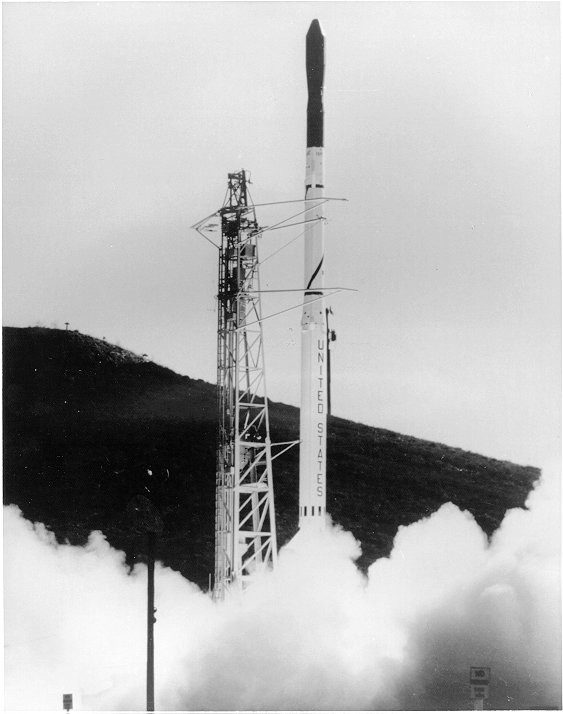
Scout X-4
In-activeVought ()
June 28, 1963
Description
The Scout family of rockets were were American launch vehicles designed to place small satellites into orbit around the Earth. The Scout multistage rocket was the first orbital launch vehicle to be entirely composed of solid fuel stages.
Specifications
-
Stages
4 -
Length
25.0 m -
Diameter
1.01 m -
Fairing Diameter
1.01 m -
Launch Mass
17.0 T -
Thrust
513.0 kN
Family
-
Name
Scout X-4 -
Family
― -
Variant
4 -
Alias
― -
Full Name
Scout X-4
Payload Capacity
-
Launch Cost
― -
Low Earth Orbit
103.0 kg -
Geostationary Transfer
Orbit
― -
Direct Geostationary
― -
Sun-Synchronous Capacity
―
Vought
Commercial
None
1917Vought was the name of several related American aerospace firms. These have included, in the past, Lewis and Vought Corporation, Chance Vought, Vought-Sikorsky, LTV Aerospace (part of Ling-Temco-Vought), Vought Aircraft Companies, and Vought Aircraft Industries. The first incarnation of Vought was established by Chance M. Vought and Birdseye Lewis in 1917. In 1928, it was acquired by United Aircraft and Transport Corporation, which a few years later became United Aircraft Corporation; this was the first of many reorganizations and buyouts. During the 1920s and 1930s, Vought Aircraft and Chance Vought specialized in carrier-based aircraft for the United States Navy, by far its biggest customer. Chance Vought produced thousands of planes during World War II, including the F4U Corsair. Vought became independent again in 1954, and was purchased by Ling-Temco-Vought in 1961. The company designed and produced a variety of planes and missiles throughout the Cold War. Vought was sold from LTV and owned in various degrees by the Carlyle Group and Northrop Grumman in the early 1990s. It was then fully bought by Carlyle, renamed Vought Aircraft Industries, with headquarters in Dallas, Texas. In June 2010, the Carlyle Group sold Vought to the Triumph Group.
Scout X-4 | FR-1
Vought | United States of AmericaVandenberg SFB, CA, USA
Dec. 6, 1965, 9:05 p.m.
Status: Launch Successful
Mission:
The FR 1 (France 1) spacecraft was a small spacecraft carrying two experiments. One was designed to observe VLF signals from earth-based transmitters, and the other was an electron density probe measuring electron concentration at the satellite.
Low Earth OrbitScout X-4 | Solrad 8
Vought | United States of AmericaWallops Flight Facility, Virginia, USA
Nov. 19, 1965, 4:48 a.m.
Scout X-4 | Beacon Explorer C
Vought | United States of AmericaWallops Flight Facility, Virginia, USA
April 29, 1965, 2:17 p.m.
Scout X-4 | San Marco 1
Vought | United States of AmericaWallops Flight Facility, Virginia, USA
Dec. 15, 1964, 8:20 p.m.
Scout X-4 | Explorer 24 & 25
Vought | United States of AmericaVandenberg SFB, CA, USA
Nov. 21, 1964, 5:09 p.m.
Status: Launch Successful
Mission:
Explorer 24 was placed in orbit together with Explorer 25 from a single launch vehicle. Explorer 24 was identical in configuration to the previously launched balloon satellites Explorer 9 and 19. The spacecraft was 3.6 m in diameter, was built of alternating layers of aluminum foil and plastic film, and was covered uniformly with 5.1-cm white dots for thermal control. It was designed to yield atmospheric density near perigee as a function of space and time from sequential observations of the sphere's position in orbit.
Elliptical OrbitScout X-4 | Explorer 23
Vought | United States of AmericaWallops Flight Facility, Virginia, USA
Nov. 6, 1964, 12:02 p.m.
Scout X-4 | Beacon Explorer B
Vought | United States of AmericaVandenberg SFB, CA, USA
Oct. 10, 1964, 3:01 a.m.
Scout X-4 | Explorer 20
Vought | United States of AmericaVandenberg SFB, CA, USA
Aug. 25, 1964, 1:43 p.m.
Scout X-4 | ESRS
Vought | United States of AmericaVandenberg SFB, CA, USA
June 25, 1964, 1:40 a.m.
Scout X-4 | Transit VC
Vought | United States of AmericaVandenberg SFB, CA, USA
June 4, 1964, 3:50 a.m.
Scout X-4 | Explorer 19
Vought | United States of AmericaVandenberg SFB, CA, USA
Dec. 19, 1963, 6:49 p.m.
Scout X-4 | GRS
Vought | United States of AmericaWallops Flight Facility, Virginia, USA
June 28, 1963, 9:19 p.m.
Status: Launch Successful
Mission:
GRS (Geophysical Research Satellite) was a geophysics experiment test built by the Cambridge Research Lab (CRL). Data was obtained for 13 orbits, after which time the satellite ceased working due to a failure in the primary power supply.
Low Earth OrbitFalcon 9
Transporter 15 (Dedicated SSO Rideshare)
Space Launch Complex 4E - Vandenberg SFB, CA, USADedicated rideshare flight to a sun-synchronous orbit with dozens of small microsatellites and nanosatellites for commercial and government customers.
Soyuz 2.1a
Soyuz MS-28
31/6 - Baikonur Cosmodrome, Republic of KazakhstanSoyuz MS-28 will carry three cosmonauts and one astronaut to the International Space Station aboard the Soyuz spacecraft from the Baikonur Cosmodrome…
Nuri
CAS500-3
LC-2 - Naro Space Center, South KoreaCAS500-3 is a South Korean Earth observation satellites to be used by the Ministry of Science and ICT for space technology verification and space sci…
Angara 1.2
Kosmos (Unknown Payload)
35/1 - Plesetsk Cosmodrome, Russian FederationNote: Payload identity and Cosmos series numbering not confirmed. Unknown Payload(s) for the Russian military.
Long March 2
Shenzhou 22
Launch Area 4 (SLS-1 / 921) - Jiuquan Satellite Launch Center, People's Republic of ChinaShenzhou 22 (Chinese: 神舟二十二号) will be the 22nd flight of the Shenzhou program. The spacecraft will be launched without crew to replace Shenzhou 20 th…

